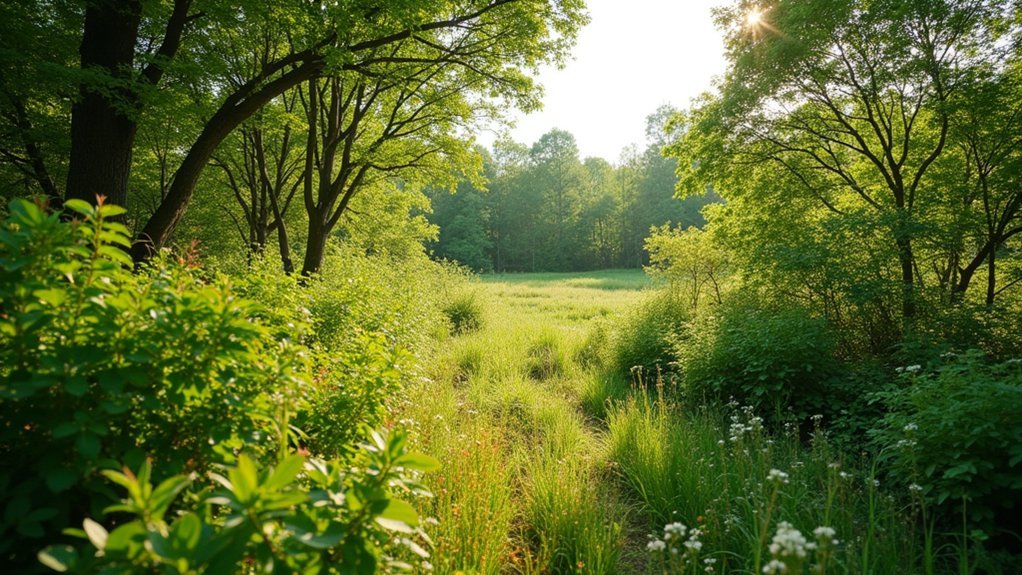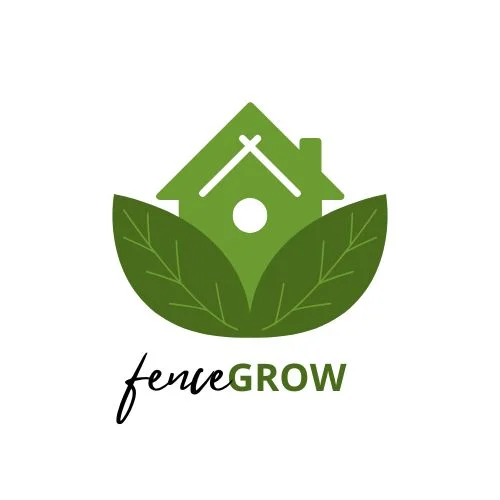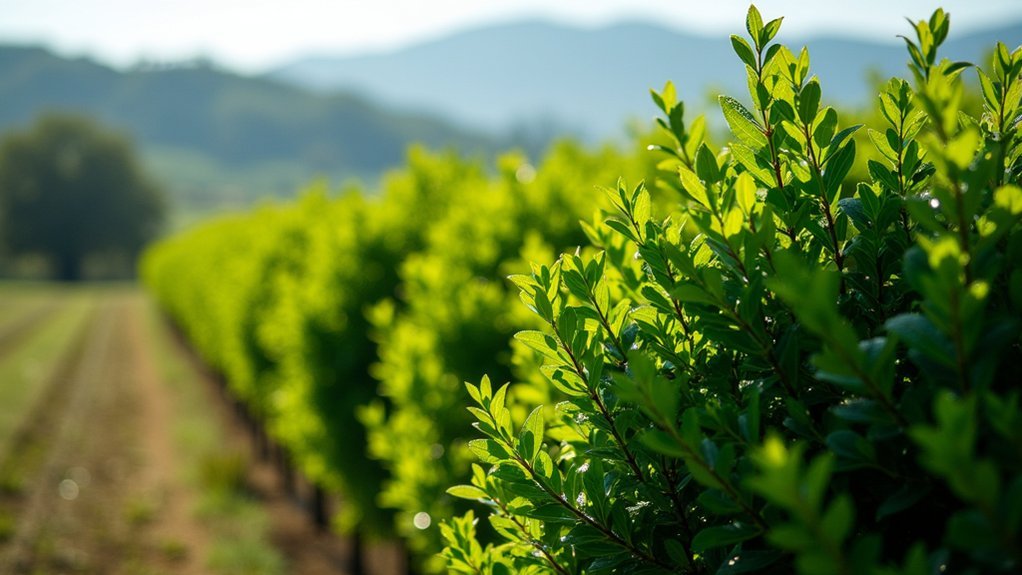Natural windbreaks offer superior protection while supporting biodiversity and wildlife. You’ll reduce wind speeds by up to 80%, creating microclimates that boost crop yields and reduce energy costs. Unlike artificial barriers, living windbreaks require minimal maintenance while continuously improving soil quality and preventing erosion. They provide year-round shelter for beneficial insects and birds while connecting fragmented habitats. Discover how these multifunctional barriers can transform your landscape into a resilient, productive ecosystem.
Enhancing Biodiversity While Creating Protected Spaces

While serving as protective barriers against harsh winds, natural windbreaks create vibrant ecosystems that foster biodiversity in multiple ways.
You’ll find these living structures provide essential woody cover and food sources that sustain diverse wildlife species where they might otherwise struggle to survive.
By planting in layers—combining trees and shrubs of varying heights—you’re creating multiple habitat strata that increase niches for birds, insects, and small mammals.
These protected microhabitats function as “outdoor barns,” sheltering wildlife from predators and extreme weather conditions.
Your windbreaks also serve as valuable corridors, connecting fragmented habitats and facilitating movement between wildlife populations. Adding species diversity to your windbreak design enhances both resilience and wildlife value of the entire structure.
Boosting Agricultural Yields Through Wind Protection
Natural windbreaks don’t just benefit wildlife—they’re agricultural powerhouses that can greatly increase your farm’s productivity. By reducing wind speeds by 70-80%, these natural barriers protect crops within a range of up to 10 times the height of your tallest trees.
Natural windbreaks transform farms into productivity zones by creating protective microclimates that extend far beyond the tree line itself.
You’ll notice improved soil quality as windbreaks prevent the loss of nutrient-rich particles and maintain moisture levels. Your crops will experience less stress, enhanced photosynthesis, and more efficient water use due to reduced evapotranspiration.
The uniform snow distribution in winter adds valuable moisture for spring planting.
When you integrate windbreaks into your farming system, you’re creating stable growing conditions that lead to measurable yield increases. Field windbreaks enhance growing conditions for crops like sunflowers, resulting in significant yield increases. Your crops benefit from year-round protection while you practice sustainable agriculture that adapts to your specific climate and soil conditions.
Economic Benefits of Living Wind Barriers

You’ll notice significant energy savings as properly designed living windbreaks reduce heating and cooling costs for buildings in their protection zone.
Your investment in windbreak establishment will pay dividends through diverse income opportunities from timber sales, biomass production, and potential carbon credits.
These natural barriers require minimal ongoing maintenance compared to artificial structures, offering long-term economic benefits with decreasing costs over time. Natural windbreaks provide stable energy pricing throughout their lifespan, mirroring the advantages seen in large-scale wind power projects.
Reduced Energy Costs
When strategically planted around your property, living windbreaks deliver substantial economic benefits through reduced energy consumption. By blocking cold winter winds, properly designed windbreaks can cut your heating costs by 10-25%, directly lowering your utility bills.
For maximum efficiency, plant evergreen trees and shrubs with dense foliage 2-5 times their mature height away from your home. Position them perpendicular to prevailing winter winds and use multiple rows for better protection. These natural barriers mitigate wind chill effects on your home while maintaining access to beneficial sunlight. An L-shaped windbreak offers superior protection against winds from multiple directions compared to a straight-line configuration.
Unlike mechanical barriers, living windbreaks provide ongoing savings without recurring costs. Your initial investment is typically offset within a few years, while simultaneously extending the life of your heating equipment and reducing your carbon footprint.
Diversified Income Streams
Beyond reducing energy costs, living windbreaks offer remarkable potential as revenue generators for property owners.
You’ll discover multiple revenue streams from a single installation—from direct crop protection that boosts yields to earning carbon credits through sequestration.
Your land value increases as windbreaks mature, while diversified farming income becomes possible through harvesting windbreak products.
You might even tap into growing agritourism opportunities by creating scenic landscapes visitors will pay to experience.
Similar to how wind farms improve rural county finances, natural windbreaks contribute to local economic sustainability.
Government programs frequently provide financial incentives, grants, and tax benefits for sustainable land management practices.
Some farmers qualify for reduced insurance premiums as windbreaks minimize crop damage risks.
Lower Maintenance Investment
While initial establishment requires patience, living windbreaks greatly reduce long-term maintenance costs compared to artificial barriers.
You’ll spend less on replanting as established trees naturally regenerate and create self-sustaining ecosystems.
Once mature, these living barriers eliminate the need for synthetic erosion control methods like silt fences, considerably cutting your labor expenses.
Your maintenance needs drop further as the canopy develops, requiring minimal pruning.
The economic advantages extend beyond direct maintenance.
You’ll use less water through improved moisture retention and reduce fertilizer dependency as soil nutrients remain preserved.
Natural pest control habitats decrease pesticide expenses, while strategic windbreak placement prevents snow drifts, eliminating removal costs.
The strategic planting of living windbreaks can provide additional income sources through harvestable products like fence posts, lumber, firewood, and even fruit.
For long-term fiscal efficiency, you simply can’t beat the sustainable economics of natural windbreaks.
Preserving Topsoil and Preventing Erosion

Since topsoil takes centuries to form naturally, protecting it from wind erosion remains critical for sustainable agriculture. Native grasses and sedges, with their fibrous root systems, effectively grab and hold soil in place, greatly reducing erosion on your property.
You’ll find that strategic windbreaks not only shield wind-sensitive crops but also control soil loss. Plants like sumac bushes and arborvitae provide effective barriers, while tall native grasses offer protection in areas where trees struggle to grow. Austrian Pine and Eastern Redcedar are excellent choices for creating dense windbreak barriers in larger landscapes.
For best results, prepare your site by maximizing moisture and minimizing weed competition.
Consider planting a diverse mix of perennials such as lilyturf and blue flag iris to stabilize soil across different conditions. These native species thrive with minimal intervention while supporting local wildlife and enhancing your land’s overall resilience.
Creating Beneficial Microclimates for Plants and Animals
Your windbreak won’t just block wind—it’ll create a temperature protection zone where plants can thrive with less stress from extreme heat, cold, and frost.
This sheltered microclimate maintains more consistent temperatures year-round, extending growing seasons and providing essential refuge during harsh weather events. Properly designed windbreaks can reduce wind velocity by up to 90% reduction, transforming a harsh environment into a protected growing area.
Wildlife will seek out your windbreak for shelter, creating a sanctuary where birds, beneficial insects, and small mammals can find protection from predators and challenging weather conditions.
Temperature Protection Zone
When properly established, temperature protection zones created by natural windbreaks offer remarkable benefits to both plants and wildlife.
You’ll find these zones extend 2-5 times the height of your windbreak on the windward side and an impressive 10-30 times the height on the leeward side.
For ideal results, aim for windbreaks with 40-60% density, which provides the perfect balance for soil protection while creating effective microclimates.
The taller your windbreak plants, the greater area you’ll protect from temperature extremes.
You’ll notice improved crop yields within these zones as plants retain more moisture and nutrients.
Your garden or farm will become more energy-efficient as windbreaks moderate temperatures year-round, providing summer shade and winter shelter while reducing heat loss and wind-related moisture evaporation.
Shelter for Wildlife
Natural windbreaks offer far more than temperature regulation—they create vibrant sanctuaries for local wildlife while establishing beneficial microclimates for your plants.
By incorporating native species like hawthorn and elder, you’ll create diverse habitats that support the entire ecosystem around your property.
Your windbreak becomes a wildlife corridor, facilitating animal movement and providing critical resources:
- Year-round shelter: Evergreen components offer nesting sites for birds and insects even during winter months
- Food resources: Plants like currants supply fruits that sustain wildlife through seasonal changes
- Biodiversity hubs: Native vegetation attracts and supports essential pollinators and beneficial insects
- Microhabitat creation: Varied plant structures create multiple niches that support different species’ needs
Selecting multiple rows of similar native plants creates resilient windbreaks that can better withstand disease and environmental stresses over time.
This ecological approach strengthens local food webs while enhancing your landscape’s resilience and functionality.
Designing Versatile Windbreaks for Multiple Functions

Creating windbreaks that serve multiple purposes requires thoughtful planning beyond basic wind protection. You’ll get superior results by combining tall trees with understory shrubs in a minimum of three rows, creating a dense, multi-layered system that mimics natural forests.
Position your windbreak perpendicular to prevailing winds, spacing rows 10-20 feet apart with plants 6-8 feet within rows. This creates a protected zone extending up to ten times the height of your windbreak. Include nitrogen-fixing species like black locust alongside fruit trees and edible shrubs to simultaneously enrich soil and provide harvests.
Maintain 40-60% porosity through selective pruning to prevent wind tunneling while still providing shelter.
Frequently Asked Questions
How Long Until Newly Planted Windbreaks Become Effective?
Your windbreak will provide noticeable protection in 3-4 years, reaching full effectiveness around 7 years. Fast-growing species accelerate this timeline, while proper maintenance during establishment guarantees you’ll achieve ideal wind reduction sooner.
Can Windbreaks Increase Pest Problems in Adjacent Fields?
No, properly designed windbreaks won’t increase pest problems in your fields. They actually support natural predators that control pests while creating microclimates that strengthen crop resilience and reduce pest vulnerability.
Which Plant Species Offer the Fastest Windbreak Establishment?
You’ll get the fastest windbreak establishment with Leyland cypress (3-5 feet yearly), Thuja ‘Green Giant’, and Norway spruce. These evergreens quickly create dense barriers while adapting to various growing conditions.
Do Windbreaks Compete With Crops for Water and Nutrients?
Yes, windbreaks do compete with crops for water and nutrients through their root systems. You’ll notice reduced crop yields near windbreaks, but you can minimize this competition through proper management like root pruning.
How Should Windbreaks Be Maintained for Maximum Longevity?
To maximize your windbreak’s longevity, inspect trees regularly, prune damaged branches in winter, water thoroughly in the first year, maintain 4-6 inches of mulch, control weeds, and plan for gradual replacement of aging trees.
In Summary
You’ve discovered how natural windbreaks offer far more than just wind protection. They’ll enhance your property’s biodiversity, boost crop yields, and save you money long-term. As you design your living barrier, you’re not just preventing erosion and creating microclimates—you’re investing in a versatile, sustainable solution that works with nature rather than against it. Your choice of natural plants delivers benefits synthetic alternatives simply can’t match.





Leave a Reply